Bertha armyworm outbreaks tend to occur in cycles. When risk is moderate to high, check all fields regularly and be prepared to take action quickly. At high numbers, they can eat a lot of pods in a short amount of time.
Bertha armyworms have one generation per year. Adult moths emerge from overwintering pupae from mid-June to late July. Moths lay 50-500 eggs in clusters on the undersides of canola leaves.
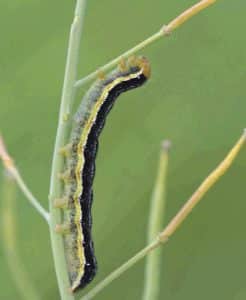
Risk estimates are based on moth counts. See the latest provincial risk report: Alberta Saskatchewan Manitoba
Eggs hatch within a week or so. Newly hatched larvae are about 0.3cm (0.1”) long. They are pale green with a pale yellowish stripe along each side. Depending on the temperature, larvae take approximately six weeks to complete their development. During this period, they moult five times and pass through six growth stages.
At maturity, the larvae are about 4cm (1.5”) long, with a light brown head and a broad, yellowish-orange stripe along each side. they can be green, brown or velvety black. Velvety black larvae have three narrow, broken white lines on their backs. Green berthas are shinier than other green worms, and the yellow-orange stripe along each side is more pronounced, even on younger ones.
Being part of the cutworm family, they curl up when agitated.
Bertha armyworms will chew holes through leaves, but the real economic damage occurs when they move up to pods. Leaf damage likely means pod damage will start soon.
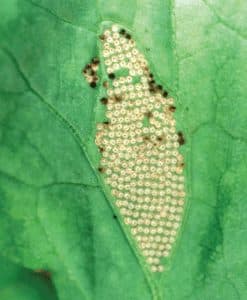
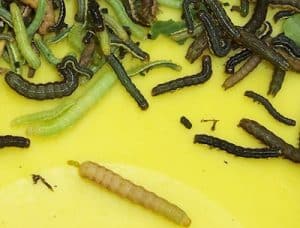
Scouting
Even if an area is low risk according to provincial risk maps, local hot spots can flare up – which is why each farm should make its own assessment on a field by field basis.
Monitor fields every few days, especially if berthas are reported in the area.
Key: Bertha armyworms do most of their feeding at night, so for daytime scouting, look on the ground and under debris to get an accurate count. You may find some worms feeding on leaves and pods during the day, but the greater number could be somewhat hidden.
Bertha scouting can be easier in the morning or evening, or on a cool, cloudy day when they will be more active.
To scout:
- Mark out a 50cm by 50cm square, which is one quarter of a square metre. Thresholds are based on counts per square metre. 50cm is the distance from elbow to finger tip, approximately.
- Vigorously shake the plants growing within that area to dislodge larvae on the plants. Push the plants aside then count the number of berthas on the ground. Larvae will hide under leaf litter and in cracks, so check closely. Picking leaf litter away, then waiting quietly a minute or so makes it much easier to count larvae as they begin to move again.
- Count the larvae on the ground and multiply by 4 to get the number per square metre.
- Sample at least 5 locations (10-15 is recommended) a minimum of 50 metres apart. Do not sample headlands and areas within the crop that are not representative of the field. Use the average number of larvae at the sites surveyed to determine if the economic threshold has been exceeded.
- Scout each field. Adjacent fields may have very different larval densities, depending on how attractive the crop was to the moths when laying their eggs.
- More on scouting from Canola Encyclopedia
If counts are close to threshold (see table below), keep looking. As retired Alberta Ag entomologist Scott Meers once said: “If the action threshold is 20 per square metre and you find 17, look more closely to make sure you’re right.”
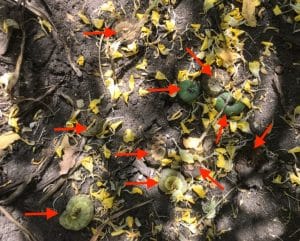
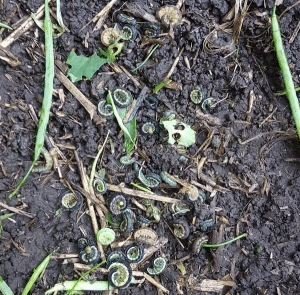
How can one field be at thresholds while a nearby field is not close?
Bertha armyworm moths are very mobile and will select ideal locations to lay eggs. This could result in one field, or even patches within a field, being preferable over others for egg laying.
Do I count all berthas, regardless of size?
You probably don’t have to count worms that are smaller than half an inch long, but come back every few days to see if they’ve grown up. This “worm size and thresholds” topic comes up during this podcast.
Should I count other green worms that look similar to bertha armyworm?
Yes, include any green worm longer than 1.25cm (half an inch). This eliminates diamondback moth larvae, which has a much different threshold. It does account for alfalfa loopers, cabbageworms and clover cutworm – all of which will eat canola.
Bertha armyworm, alfalfa looper, cabbageworm and clover cutworm are green (or have green phases). Clover cutworm, like bertha, can also have brown or black phases. Clover cutworm also has a side stripe – but the stripe is pink while the bertha stripe is yellow or orange.
Alfalfa looper has white stripes down the sides and back. It loops when it walks, while bertha armyworm does not.
Cabbageworms (larvae of cabbage butterfly) are covered in short hairs, giving them a velvety appearance.
Why bother counting, why not just spray?
Having a few bertha armyworm larvae can be helpful and important. They serve as hosts that attract and retain natural enemies, especially predatory arthropods but also viral, bacterial and fungal diseases that attack bertha armyworms. Scouting and application of the economic threshold helps growers support these important interactions. Of course, action is required when economic levels of damage are present.
Thresholds table
Bertha armyworm economic thresholds
The bertha armyworm larval density at which an insecticide treatment in canola would be warranted (depending on expected seed value and spraying costs).
| Expected canola seed value ($/bushel) | |||||||||||
|---|---|---|---|---|---|---|---|---|---|---|---|
| 10 | 11 | 12 | 13 | 14 | 15 | 16 | 17 | 18 | 19 | 20 | |
| Spraying cost ($/acre) | Threshold (larvae per square metre) based on seed value by spray cost | ||||||||||
| 7 | 12 | 11 | 10 | 9 | 9 | 8 | 8 | 8 | 8 | 8 | 8 |
| 8 | 14 | 13 | 11 | 11 | 10 | 9 | 9 | 9 | 9 | 9 | 9 |
| 9 | 16 | 14 | 13 | 12 | 11 | 10 | 10 | 10 | 10 | 10 | 10 |
| 10 | 17 | 16 | 14 | 13 | 12 | 11 | 11 | 11 | 11 | 11 | 11 |
| 11 | 19 | 17 | 16 | 15 | 14 | 13 | 12 | 11 | 11 | 10 | 10 |
| 12 | 21 | 19 | 17 | 16 | 15 | 14 | 13 | 12 | 12 | 11 | 10 |
| 13 | 22 | 20 | 19 | 17 | 16 | 15 | 14 | 13 | 12 | 12 | 11 |
| 14 | 24 | 22 | 20 | 19 | 17 | 16 | 15 | 14 | 13 | 13 | 12 |
| 15 | 26 | 23 | 22 | 20 | 19 | 17 | 16 | 15 | 14 | 14 | 13 |
| 16 | 28 | 25 | 23 | 21 | 20 | 18 | 17 | 16 | 15 | 14 | 13 |
| 17 | 29 | 26 | 25 | 23 | 21 | 20 | 18 | 17 | 16 | 14 | 13 |
| 18 | 31 | 28 | 26 | 24 | 22 | 21 | 19 | 18 | 16 | 15 | 14 |
| 19 | 33 | 29 | 28 | 25 | 24 | 22 | 20 | 18 | 17 | 16 | 14 |
| 20 | 34 | 31 | 29 | 27 | 25 | 23 | 21 | 19 | 18 | 16 | 15 |
| 21 | 36 | 32 | 31 | 28 | 26 | 24 | 22 | 20 | 19 | 17 | 16 |
| 22 | 38 | 34 | 32 | 30 | 28 | 25 | 23 | 21 | 19 | 18 | 16 |
| 23 | 39 | 35 | 34 | 31 | 29 | 26 | 24 | 22 | 20 | 18 | 17 |
| 24 | 41 | 37 | 35 | 32 | 30 | 28 | 25 | 23 | 21 | 19 | 17 |
| 25 | 43 | 38 | 37 | 34 | 31 | 29 | 26 | 24 | 21 | 19 | 18 |
| 26 | 44 | 40 | 38 | 35 | 33 | 30 | 27 | 25 | 22 | 20 | 18 |
| 27 | 46 | 41 | 40 | 36 | 34 | 31 | 28 | 25 | 23 | 21 | 19 |
| 28 | 48 | 43 | 41 | 38 | 35 | 32 | 29 | 26 | 24 | 21 | 19 |
| 29 | 50 | 44 | 43 | 39 | 36 | 33 | 30 | 27 | 24 | 22 | 20 |
| 30 | 51 | 45 | 45 | 40 | 38 | 35 | 31 | 28 | 25 | 23 | 20 |
Management
For best results, apply an insecticide as soon as the field reaches economic thresholds.
- Ensure the larvae are at least 1.3 centimetres (0.5 of an inch) long.
- Apply the insecticide early morning or late evening when larvae are feeding. Do not apply during warm afternoons.
- A single, well-timed application of any registered insecticide through aerial or high clearance ground equipment is usually effective.
- Use enough water to ensure adequate coverage.
- Use the higher label rate – for products with a rate range on the label.
More…
- Bertha armyworm chapter in the Canola Encyclopedia
- Take the bertha armyworm quiz for more on bertha identification and scouting
- Canola Watch podcast on bertha armyworm activity
